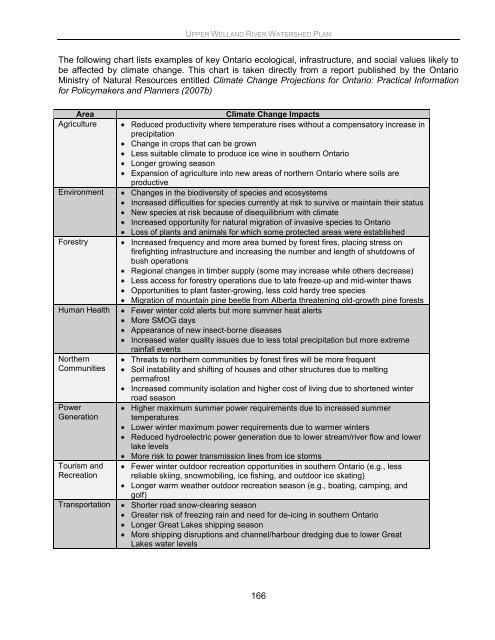Upper Welland River Watershed Plan - Niagara Peninsula ...
Upper Welland River Watershed Plan - Niagara Peninsula ...
Upper Welland River Watershed Plan - Niagara Peninsula ...
Create successful ePaper yourself
Turn your PDF publications into a flip-book with our unique Google optimized e-Paper software.
UPPER WELLAND RIVER WATERSHED PLANThe following chart lists examples of key Ontario ecological, infrastructure, and social values likely tobe affected by climate change. This chart is taken directly from a report published by the OntarioMinistry of Natural Resources entitled Climate Change Projections for Ontario: Practical Informationfor Policymakers and <strong>Plan</strong>ners (2007b)AreaAgricultureEnvironmentForestryHuman HealthNorthernCommunitiesPowerGenerationTourism andRecreationTransportationClimate Change ImpactsReduced productivity where temperature rises without a compensatory increase inprecipitationChange in crops that can be grownLess suitable climate to produce ice wine in southern OntarioLonger growing seasonExpansion of agriculture into new areas of northern Ontario where soils areproductiveChanges in the biodiversity of species and ecosystemsIncreased difficulties for species currently at risk to survive or maintain their statusNew species at risk because of disequilibrium with climateIncreased opportunity for natural migration of invasive species to OntarioLoss of plants and animals for which some protected areas were establishedIncreased frequency and more area burned by forest fires, placing stress onfirefighting infrastructure and increasing the number and length of shutdowns ofbush operationsRegional changes in timber supply (some may increase while others decrease)Less access for forestry operations due to late freeze-up and mid-winter thawsOpportunities to plant faster-growing, less cold hardy tree speciesMigration of mountain pine beetle from Alberta threatening old-growth pine forestsFewer winter cold alerts but more summer heat alertsMore SMOG daysAppearance of new insect-borne diseasesIncreased water quality issues due to less total precipitation but more extremerainfall eventsThreats to northern communities by forest fires will be more frequentSoil instability and shifting of houses and other structures due to meltingpermafrostIncreased community isolation and higher cost of living due to shortened winterroad seasonHigher maximum summer power requirements due to increased summertemperaturesLower winter maximum power requirements due to warmer wintersReduced hydroelectric power generation due to lower stream/river flow and lowerlake levelsMore risk to power transmission lines from ice stormsFewer winter outdoor recreation opportunities in southern Ontario (e.g., lessreliable skiing, snowmobiling, ice fishing, and outdoor ice skating)Longer warm weather outdoor recreation season (e.g., boating, camping, andgolf)Shorter road snow-clearing seasonGreater risk of freezing rain and need for de-icing in southern OntarioLonger Great Lakes shipping seasonMore shipping disruptions and channel/harbour dredging due to lower GreatLakes water levels166
















